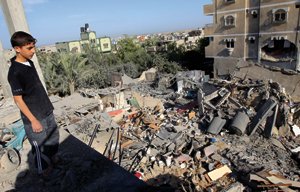CQ WEEKLY – VANTAGE POINT
Nov. 24, 2012 – 10:44 a.m.
Rockets and Retweets
By Jonathan Broder, CQ Staff
Predictably, both the Senate and the House adopted resolutions Nov. 15 and 16 affirming Israel’s right to self-defense in its latest military campaign against Palestinian militants in the Gaza Strip. But the Israeli military is reaching far beyond Capitol Hill for support, using social media for the first time to win sympathizers around the world.

|
||
|
From the moment the campaign began on Nov. 14 with the targeted killing of the top Hamas military commander in Gaza, the Israel Defense Forces has been pumping out a steady stream of battlefield updates in English on Twitter, YouTube, Facebook and Tumblr. The idea, say Israeli officials and Middle East experts, is to present an unfiltered Israeli version of the assault and its justifications to the traditional media, as well as social-media users, in the hope they’ll pass along these updates. The IDF’s Twitter account has almost 200,000 followers.
“More than 12,000 rockets hit Israel in the past 12 years. RT if you think #Israel has the right to defend itself,” an IDF spokesman tweeted on the first day of fighting. More than 6,200 people have retweeted it so far. Meanwhile, the IDF’s Facebook page displays a poster showing rockets raining down on landmarks in London, Paris, New York and Sydney. “What would you do?” the caption asks.
Aaron Zelin, a Middle East expert at the Washington Institute for Near East Policy, a pro-Israel think tank, says the IDF considers its media campaign to win hearts and minds around the world as important as its airplanes on the battlefield. He calls Twitter and other social media “force multipliers” for Israel’s information effort.
The media campaign is also an effort to get ahead of possible bad publicity. Israel didn’t have that opportunity during its last incursion into Gaza in 2008, when social media sites such as Twitter were still in their infancy. Some 1,400 Palestinians died in that campaign, which produced horrific video of civilian casualties. Three Israeli civilians were killed. The United Nations later issued a report that accused both Israel and Hamas of war crimes for targeting civilians.
The IDF is also using Twitter to warn journalists of danger. “Warning to reporters in Gaza: Stay away from Hamas operatives & facilities,” the IDF tweeted. “Hamas, a terrorist group, will use you as human shields.” At least three journalists have been killed and nine wounded so far in Israeli airstrikes.
Meanwhile, Gaza sympathizers are tweeting under the hashtag #GazaUnderAttack to express their own views, ranging from boasts about the Palestinians’ arsenal of missiles to laments over civilian casualties. On Nov. 16, Twitter account @StealthyEmirati retweeted a photo showing a small boy in Gaza standing in a pool of blood holding a squeegee under the words, “How would it feel to mop your family’s blood? Ya Allah, help Palestine.”
Some Israelis are uncomfortable with the gloating tone of some IDF tweets, such as one that showed a picture of Hamas military chief Ahmed Jabari and the bolded word, “Eliminated.” Ori Nir, spokesman for Americans for Peace Now, the U.S. branch of an Israeli group that backs a negotiated Israeli-Palestinian peace, calls such communications “crude.”
Zelin is skeptical about the success of social media spin. “It’s more galvanizing people who are already supporting Israel,” says Zelin, who has tracked the IDF’s social media blitz. “It’s far from clear that it has succeeded in casting a wider net.”